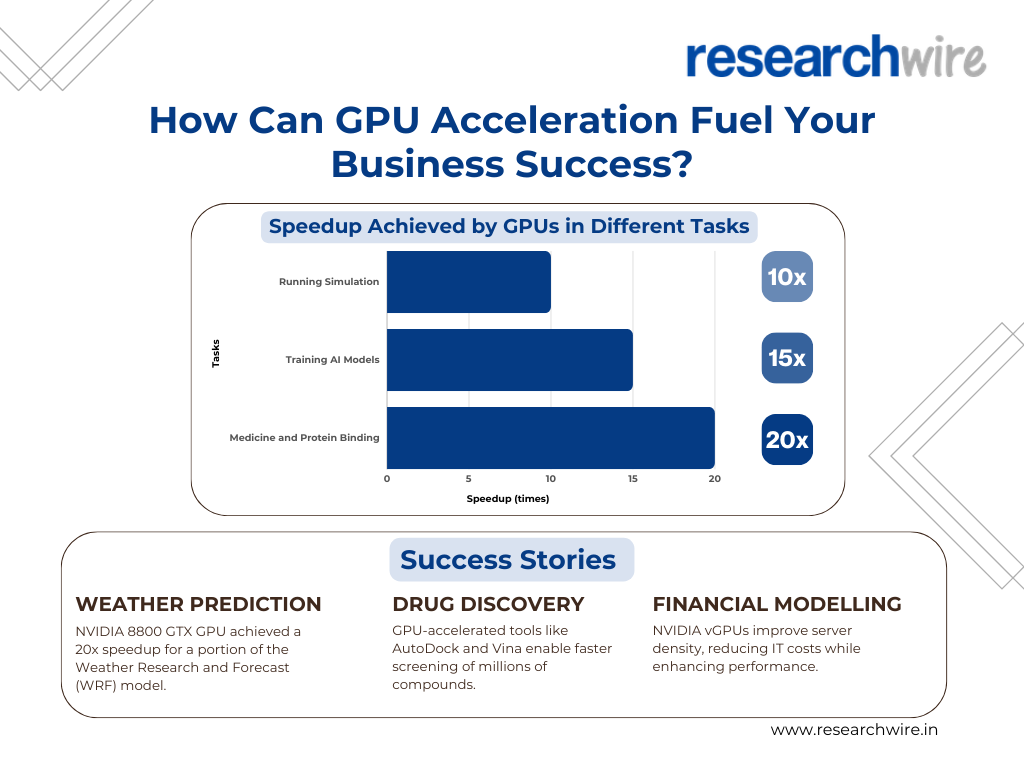Rohit Kumar is responsible for Researchwire European & North American business. He is an HEC, Paris 2008 MBA and Indian Institute of Technology (IIT) Kharagpur 2002 engineering graduate with close to 17 years of experience in business innovation and strategy, business development and client relationship roles. He is working with ResearchWire since 2016 and as a partner, is responsible for the growth of ResearchWire in Europe and North America.
Prior to ResearchWire, Rohit was handling sales strategy and pricing for Syniverse Technologies, a telecom services provider, where he was instrumental for growth in EMEA and India through product innovations, creative pricing and discounting models and executing strategic sales plans.
Rohit is based out of Luxembourg and has been living in Europe for last 12 years. He understands European & North American customers and their needs and ensures that our customers always have a local person to reach out whenever needed.
The Growing Demand for High-Performance Computing
The exponential growth of data and the increasing complexity of computational tasks are driving a relentless demand for faster processing power. Across diverse fields like artificial intelligence, data science, and engineering simulations, businesses are pushing the boundaries of what’s possible.
Traditional computing architectures are struggling to keep pace, creating significant growth opportunities for high-performance computing (HPC) solutions.
As the demand for high-performance computing surges, a powerful technology known as the Graphics Processing Unit (GPU) is emerging as a game-changer. Let’s explore the unique architecture of GPUs and how their parallel processing prowess can propel businesses towards significant growth.
GPU Architecture and Advantages
GPUs, or Graphics Processing Units, differ significantly from CPUs (Central Processing Units). While CPUs excel at handling a few tasks simultaneously, GPUs are designed for parallel processing. This makes them perfect for tasks requiring handling many operations at once, such as training AI models or running detailed simulations.
Parallel processing allows GPUs to handle numerous calculations simultaneously. When we’re trying to figure out if a new medicine will stick to the right protein in our body, there’s a ton of math involved in checking all the different ways they could fit together.
GPUs have a whole bunch of cores that can split up the work, so we don’t have to perform each calculation one at a time – it’s like having a huge team of scientists in your computer! This makes the predictions much faster and more on point. Overall, GPUs are clutch for drug discovery because of how they can crank through piles of parallel math at lightning speed.
Continuous innovations are enhancing GPU capabilities, making them faster and more efficient with features like AI-specific hardware.
Democratization of Computing
GPU acceleration is no longer just for large corporations. Advances in technology and reductions in cost are making high-performance computing accessible to smaller businesses and individual researchers.
Cloud-based GPU solutions offer scalable options, eliminating the need for hefty upfront investments in hardware.
Success Stories of GPU Acceleration
-
Weather and Climate Prediction
Software has relied on increasing processor speeds for performance gains over the past 50 years. As this trend nears its end, an alternative method using fine-grain parallelism on emerging architectures, like GPUs, offers promise.
For example, an NVIDIA 8800 GTX GPU achieved a 20 times speedup for a portion of the Weather Research and Forecast (WRF) model, suggesting a potential overall 1.3 times speedup.
-
Drug Discovery
- High-Throughput Virtual Screening: GPU-accelerated virtual screening tools like AutoDock and Vina enable faster screening of millions of compounds from large chemical libraries. This acceleration speeds up the identification of potential drug candidates, streamlining drug discovery pipelines.
- Accelerated Docking Simulations: GPU-accelerated docking software like GOLD and DOCK enhances the speed and accuracy of molecular docking, which predicts the binding orientation of small molecules to target proteins. This facilitates the identification of new drug candidates and a better understanding of drug-target interactions.
-
Breakthroughs in Financial Modelling with GPU Acceleration
GPU acceleration is revolutionizing financial modelling by enhancing performance, security, and manageability. It supports virtual desktop infrastructures (VDI), enabling superior performance on productivity and high-performance applications like Bloomberg and electronic trading platforms.
NVIDIA vGPUs improve server density, reducing IT costs while upgrading user experience. They also enable rapid setup for large-scale deployments, improving scalability and manageability.
This results in faster data processing, improved productivity, and more efficient IT infrastructure utilization in the financial sector.
Challenges and Considerations
Programming Complexity
- Steep Learning Curve: Programming models for GPUs differ significantly from those for CPUs. Developers may require specialist training to fully utilize GPU capabilities. The transition demands an understanding of parallel programming and specific frameworks like CUDA and OpenCL.
- Debugging Challenges: Debugging GPU code can be more complex compared to CPU code. It requires specific tools and knowledge, making troubleshooting more difficult and time-consuming.
Software and Hardware
- Compatibility Problems: Not all software libraries and applications are designed to leverage GPUs. Before deployment, testing for compatibility is necessary to ensure that existing applications can benefit from GPU acceleration without major rewrites.
- Vendor Lock-in: Different GPU manufacturers offer proprietary programming tools and technologies. This can lead to vendor lock-in, reducing the flexibility and adaptability of the infrastructure.
- Power Consumption: While GPUs provide high computing power, they consume significant energy. Effective power management techniques must be implemented to balance performance with energy efficiency.
Security Issues
- Vulnerability to Attacks: GPUs have different attack surfaces compared to CPUs. Strong security measures, such as encryption and access control, are imperative to protect sensitive data and maintain system integrity.
- Updates for Drivers and Firmware: Regular updates to GPU drivers and firmware are essential to address potential security flaws. This ongoing maintenance ensures that the system remains secure and up to date.
Integration with Existing Systems
- Data Transfer Bottlenecks: Transferring large datasets between GPUs and existing CPU-based infrastructure can create performance bottlenecks. Optimizing data transfer protocols is crucial to maintain efficiency.
- Legacy System Compatibility: Integrating GPU-based solutions with older systems may require significant modifications or a complete overhaul, depending on the compatibility. This can add to the complexity and cost of implementation.
Training and Skill Development
- Specialized Knowledge: Developers need to be proficient in GPU architectures and parallel programming techniques. Hiring skilled personnel or providing comprehensive training programs is essential for maximizing GPU benefits.
- Continuous Learning: GPU computing is a rapidly evolving field. Continuous investment in training and development is necessary to keep the workforce updated with the latest technologies and tools.
The Future of GPU Acceleration
Predicted Developments
- Sophisticated Architectures: The future of GPU technology promises even more specialized architectures tailored for specific workloads, such as artificial intelligence (AI) and scientific computing. These advanced designs will enhance performance for niche applications, making GPUs more efficient and effective for targeted tasks.
- Enhanced Efficiency: Innovations in memory and chip design are expected to significantly improve GPU performance while reducing power consumption. These advancements will make GPUs not only faster but also more energy-efficient, addressing one of the key concerns associated with high-performance computing.
- Software Simplification: The development of more user-friendly programming tools and frameworks will democratize access to GPU computing. As these tools become easier to use, a broader range of developers will be able to leverage the power of GPUs, driving innovation across various industries.
Cloud-Based Solutions
- Accessible GPU Instances: Cloud providers are increasingly offering accessible GPU instances, allowing businesses to harness GPU capabilities without substantial upfront investments. This shift towards cloud-based solutions makes GPU acceleration more affordable and scalable, enabling organizations of all sizes to benefit from high-performance computing.
- Flexible Scaling: Cloud-based GPU solutions provide flexibility in scaling resources according to demand. Businesses can dynamically allocate GPU power as needed, optimizing costs and ensuring that they only pay for what they use. This model is particularly advantageous for startups and small to medium-sized enterprises (SMEs) that need powerful computing resources but cannot afford significant capital expenditure.
- Enhanced Collaboration: Cloud platforms facilitate enhanced collaboration by providing a centralized environment for GPU-accelerated projects. Teams can access shared resources, collaborate in real-time, and streamline workflows, making it easier to manage complex projects and accelerate innovation.
- Integration with AI and IoT: The combination of GPUs with cloud-based AI and IoT solutions is driving the development of more responsive and intelligent systems. For example, smart cities and autonomous vehicles can process and analyse data in real-time, leveraging the immense computational power of GPUs hosted in the cloud. This integration enhances the functionality and efficiency of these systems, paving the way for advanced applications and services.
Strategic Recommendations for Business
- Investment Methodologies: ResearchWire can help your company develop specialized investment plans tailored to your financial resources and corporate goals, ensuring efficient allocation of funds towards GPU technology and infrastructure.
- Partnership Opportunities: We facilitate joint ventures and strategic partnerships to leverage combined knowledge, assets, and market access, ensuring the successful integration and maximization of GPU computing capabilities.
- Adoption and Integration Roadmap: ResearchWire provides a well-organized strategy outlining essential steps for integrating GPU technology into your existing processes and infrastructure, minimizing disruptions and maximizing efficiency.
Patent Portfolio Development
GPU Patent Portfolio: At ResearchWire, we specialize in helping companies build robust patent portfolios related to GPU technology. Our services include identifying patentable innovations, preparing and filing patent applications, and managing the portfolio to ensure it aligns with your strategic business goals. We aim to protect your intellectual property and provide a competitive edge in the rapidly evolving GPU landscape.
Researchwire assists companies in developing comprehensive patent portfolios for AI, IoT, and connectivity, streamlining the patent filing process and providing insights into the latest technological trends.
Researchwire is an ISO 27001 certified, specialised IP research and R&D support company. Works closely with IP & legal teams to provide patent portfolio services and all types of patent searches & patent drafting. It provides enterprises and R&D centres with insightful and effective solutions to address their technology development challenges and roadmap planning.
Conclusion
The future of GPU acceleration is bright, with significant advancements in technology and accessibility on the horizon. Sophisticated architectures, enhanced efficiency, and simplified software frameworks will make GPUs more powerful and user-friendly.
Cloud-based solutions will further expand accessibility, allowing businesses to leverage GPU capabilities without significant investments. These developments will drive innovation across various industries, enabling faster, more efficient computing solutions and transforming the landscape of high-performance computing.



